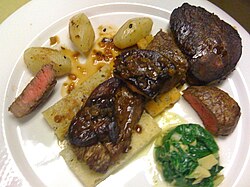| Part of a series on |
| Steak |
|---|

This is a list of steak dishes. Steak is generally a cut of beef sliced perpendicular to the muscle fibers, or of fish cut perpendicular to the spine. Meat steaks are usually grilled, pan-fried, or broiled, while fish steaks may also be baked. Meat cooked in sauce, such as steak and kidney pie, or minced meat formed into a steak shape, such as Salisbury steak and hamburger steak, may also be referred to as "steak".








